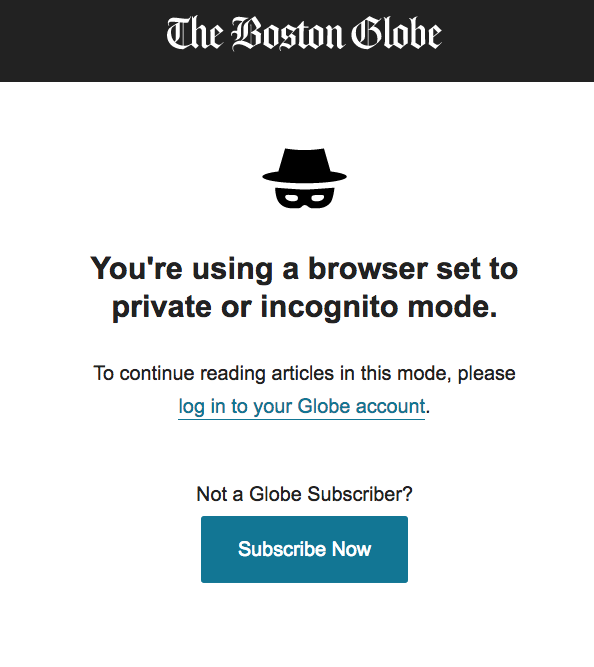
Earlier this month, BostonGlobe.com readers were surprised to find that a popular way of skirting the site’s paywall had been quietly closed. By visiting the site in their browser’s private mode, readers were able to circumvent the site’s free article limit, letting them read more articles than they would otherwise. And that wasn’t the only major change to the site’s paywall recently: At the end of April, the Globe also cut back on the number of articles it let visitors read for free every 45 days — from five articles to a mere two.
These changes, while jarring to many readers, are part of the Globe’s ongoing strategy to “strike the right balance between giving users the opportunity to sample content and getting them to subscribe,” said Peter Doucette, chief consumer revenue officer at Boston Globe Media. “We’ve been constantly experimenting with finding that balance, because fundamentally we believe the Globe’s journalism is worth paying for.” A lot of people agree: The Globe’s digital subscriber count currently sits at roughly 84,000, up from around 65,000 a year ago. That’s the most of any local newspaper in the country.

Tim Griggs, an independent media consultant and the former publisher of The Texas Tribune, said that the beauty of the metered paywall is that it gives news organizations plenty of flexibility to tweak how many free articles to offer readers, how often to reset the meter, what factors affect the meter, and how to message all of this to potential subscribers. If a hard paywall is a hammer, the metered paywall is a scalpel. “It’s an elegant solution when done with the right data rigor and the right user experience,” Griggs said in an email. “Many news sites aren’t so great at either of those things.” Indeed, former Globe executive and Nieman Fellow David Skok wrote for us last year about the importance of using reader data and predictive analytics to determine optimal times to raise or lower the paywall:
There’s a lot of evidence news organizations are getting more nuanced with their approaches — and that over time has resulted in paywalls with fewer holes, not more. The Wall Street Journal, which has put most stories behind a hard paywall since the 1990s, recently closed a feature that let visitors skirt restrictions by pasting a story’s headline in Google. It also recently killed of a secret (yet surprisingly well-known) free login popular among those in media circles. With the moves, it joined The Washington Post, which has been testing efforts to close loopholes that let visitors access its content for free.Imagine a reader browsing the web on their smartphone while on a train heading into work. They click on a link through Reddit and arrive on your news site where they are served a paywall. Using predictive analytics, we are quite certain that this Reddit mobile reader will not subscribe to your website. In fact, the reader may even post on Reddit just how much she despises your paywall. So, instead of wasting our time trying to get that reader to subscribe, what other kinds of value can you exchange with her that could be of mutual benefit? Perhaps it’s an email newsletter signup form that could begin an inbound marketing relationship? Perhaps it’s a video preroll ad with a high CPM to generate maximum ad revenue? Perhaps it’s a prompt for the reader to “like” you on Facebook so that they can help expand your reach?
Premium news organizations in 2017 are in a constant process of opening and closing paywall loopholes, depending on their goals. Griggs illustrated how the early parts of this process worked at The New York Times, which from 2011 to 2013 evaluated how to handle and respond to “avoidance behaviors” such as cookie deletion. One finding was that people who deleted cookies to avoid the Times’ paywall were also more likely to subscribe than people who did not delete cookies — likely because those cookie deleters were also some of the most frequent readers. When news organizations recognize this kind of behavior, they’re able to try new ways of reaching those readers, such as targeting them with specific soft messaging. News organizations can repeat this process for each of the various workarounds, all of which necessitate their own specific approaches.
Griggs agreed that, as publishers get smarter about understanding reader behavior, their paywalls tend to get less leaky. “When you’re talking about a relatively new line of business, there’s a lot to study and learn, there’s a lot to test, and there’s a marketplace shift happening at the same time,” he said. “So you can understand and act on things you previously didn’t know.” (The Times, for example, designed its paywall to be comparatively porous at first in an effort to collect as much data as possible.)
Doucette said that publishers are “now entering a second generation of digital models.” In the first generation, publishers were just trying to prove out the concept that consumers would pay up. With that accomplished, many are now focused on optimizing and building on that model. “We’ve learned a lot in five years about what the levers are, how we can pull them and what are the tradeoffs,” Doucette said. “We understand a lot of things better than we used to. The changes are the natural evolution of that understanding.”